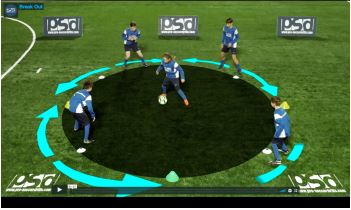3-4-1-2 System of Play
Preamble
Systems nowadays receive more and more attention as all football coaches try to add value to their team through their tactical vision and style. They often break down game tactics into small parts (mosaics) in terms of moments/phases of the game, principles (sub-principles, sub-sub-principles, etc…) or spatial awareness. Therefore, they intentionally try to create overloads and try to gain advantage of during the work done in the pre-game preparation period.
A very common club approach is that they define their playing style and all their teams from the youngest youth team to the first team have to play in the pre-determined style of play. However, most of the times the system of play is not strict and can vary within the different teams. There are many football matches played between two teams who try to implement a very similar style of play (e.g. short-passing, triangle-based, combination game) with two totally different systems of play. During these games, tactical preparation and consciousness can make the difference.
Nowadays, there are some common and most-fancied systems of play, like the 4-3-3, 4-4-2 or 3-4-3. Although, it’s important for all coaches to get familiar with other systems as well, maybe they can benefit from any information.
General Overview
The 3-4-1-2 system of play may look a little bit complicated as it consists of four lines. Actually, when it comes to the formation, coaches can create and handle more lines than four.
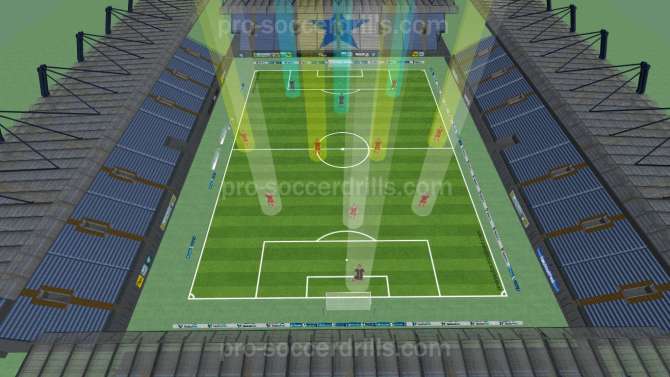
This system of play has 3 players in the back line; these players can be called centre backs as they exploit the central spaces to defend their goal.
In front of these players, there are 4 midfield players that can be separated and distributed many different ways, but their main role is to give support to the defensive line and also give width to the team.
There are 3 attackers in this system: a typical number 10 role and two regular attackers. Naturally, these players can be given different tactical roles and responsibilities as well.
Regardless of how coaches place their players exactly, the 3-4-1-2 formation is able to provide many different advantages to them:
- 3 defenders to have defensive stability – giving the team confidence
- Overload in central midfield areas – as the number 10 player can drop back to create numerical superiority – or the wing players to play towards the centre for the same reason
- 2 attackers can occupy the opponent’s defenders dragging them around the pitch – or creating free vertical passing options by dropping in between lines
- Many different diagonal passing options.
It is important to talk about the diagonals in the 3-4-1-2.
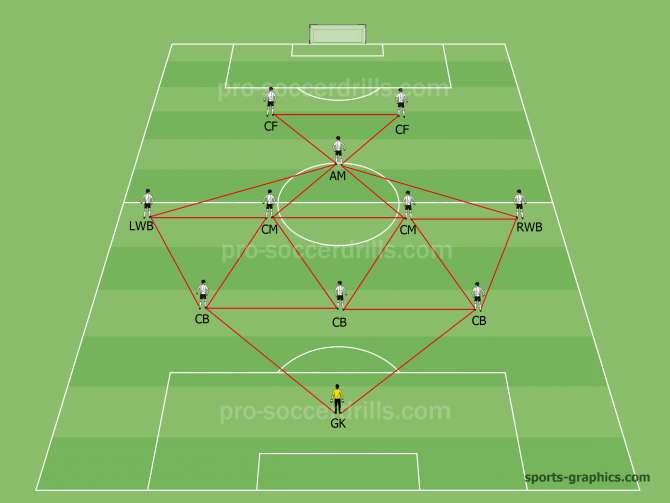
Either diagonals or triangles are used intentionally by coaches, therefore, if a coach plans on these, this system of play can be used very efficiently to turbo-boost their concept and style of play.
The Back Three
Playing with three backs is getting more and more popular as it may give stability to the team defence-wide and also can be adjusted for bringing the ball out of the back with short passes. The central centre defender would exploit the centre-space while the two “side” centre defender could position themselves on the wing edges of the half-spaces. This means, these players distribute the spaces in a very effective way. Naturally, the defender in the middle must have great ball skills in order to change the play very quickly in possession. This player’s role is similar to the player dropping back in between the other defenders when there are only two centre backs.
The two side defenders should be able to get the ball forward and play those vertical passes in order to build the attacks. These defenders might have the opponent attacking them from the flanks, so they need spatial awareness as well during the times they receive passes.
In the defensive phase, out of possession, these three defenders play a decisive role to stop the opponent from scoring. They have to mark the opponent’s central attackers and their players who step into the play from the further areas. Their most important role is to cover the centre space in front of goal. From the numerical point of view it gives the opportunity for the players to pick up one or two attackers and mark them. Good communication is key. These players shouldn’t cover flank areas, but they need to be ready to complete the defensive line into a back four if the situation requires.
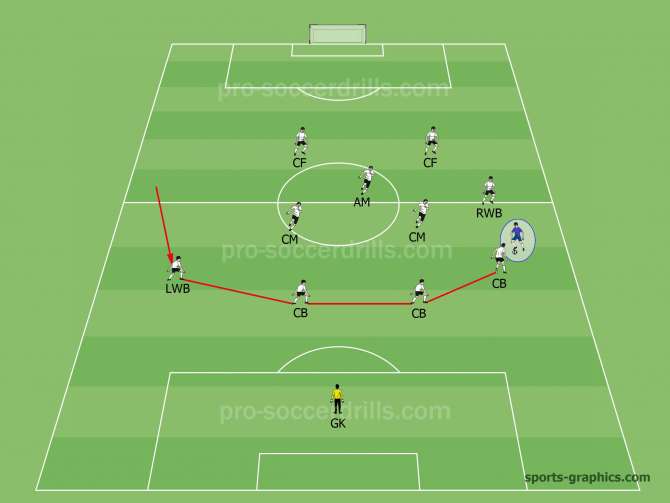
Therefore, there is a big pressure on the side defenders as they need to accommodate to more positions and responsibilities.
The Midfield Four
In the 3-4-1-2 system the midfield four can be implemented many different ways. Their role is really important as they need to give support in the central areas not letting the opponent break through and they have to cover the flank areas as well in defence and in attack as well.
Therefore, the two central midfielders have to cover the spaces between the flanks but they also need to fill in the gaps vertically like box-to-box midfielders. Therefore, not only do they need big working capacity as their possible workload is huge, but they need to dictate the tempo and give the game a feeling that they’re available all the time in defence and in attack as well.
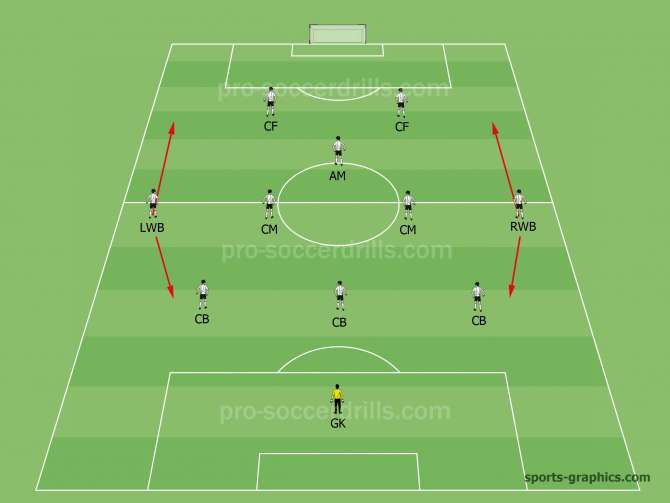
The two side midfielders, the wingers have very important roles as there is nobody else in the formation that can cover the flank areas. Therefore, they also need very high working capacity as they need to run up and down the pitch always covering the space near the ball in the flank areas. They have to make sure that their teammates have a wide diagonal option to build up the play in attack.
As central attackers and central players might occupy the opponent’s players, these wingers might have less attention by the opponent’s wing backs or full backs. Therefore, the importance is bigger as they have to give width to the team in possession.
In defence, out of possession, they have to act as wingers and full backs as well. They have to be very disciplined when it comes to helping the three defenders out. They have to drop back and act as the fourth defender completing the back three to a back four sometimes. Their defensive skills might be important depending on the actual opponent. Therefore, they should have high-level game intelligence and good 1v1 skills either in defence and attack.
The Number 10
The player who plays behind the lone striker or two strikers is usually the most creative player of the team. In this formation, this position can be a free, floating position as these players have the cover of two central midfielders and have the two players upfront who can make the opponent’s defenders busy giving more space to exploit for the number 10.
In attack, this player can be given many different tactical instructions from dropping back to help the attack build up to stepping upfront next to the strikers. This player can also go wide and run behind the strikers in the flank areas freeing up the midfield 4 from working too much.
The Two Attackers
As in every formation, two strikers can be played differently. They can play in a 1-1 formation, diagonally placed or next to each other.

In this formation they have the space and the option as well to play in many different ways unpredictably for the opponents. Usually these two attackers are natural finishers but they need to contribute numerically to the other parts of the team. They have to drop back sometimes between lines but in the meantime they need to pay attention to occupying the central defenders as well. There is an opportunity to find space between the centre backs and full backs when it comes to exploiting empty spaces. If the team works well together, these strikers can pick up the ball in very good spaces during fast-paced counter-attacks.
In defence, there is a good option for the team to put the opponent under pressure by man-marking them around the ball. The two strikers cooperating well can lead to man-marking the centre backs preventing them to build up the play properly.
These two attackers must be able to play facing their own goal with and without the ball. If there are two different personalities as attackers in the team, 3-4-1-2 can be a good option to them.
Summary
3-4-1-2 is a very versatile and flexible system of play. Coaches can adjust and modify the formation as they want to in order to get the maximum out of the players. Especially in the short, combinative style of play it is useful to have natural, structural triangles and diagonal passing lanes. This style of play give the coaches the freedom and the stability noting that the wing player would work really-really hard during the games. Key aspect is they need support.
Creating numerical and positional overload, 3-4-1-2 is a really efficient system to use for coaches. Although, team tactics must be created very intelligently in order to have the team operate well together. Apart from the togetherness, it is a very challenging system of play, but can support ball possession-based styles on a very high level.
Free Trial
GET YOUR FREE 14 - DAYS TRIAL NOW! INCLUDING:




